by Susan Flantzer
© Unofficial Royalty 2025
The heraldic coat of arms of the Gumsehuvud family, Katarina’s birth family; Credit – Av Dan Köhl – Eget arbete, CC BY 3.0, https://commons.wikimedia.org/w/index.php?curid=76271138
Katarina Karlsdotter Gumsehuvud was the second wife of Karl Knutsson Bonde, who reigned as King Karl VIII of Sweden in 1448-1457, 1464-1465, and 1467-1470 and as King Karl I of Norway from 1449 to 1450. Born in 1418 in Stockholm, Sweden, Katarina was the daughter of Swedish nobleman Karl Ormsson Gumsehuvud (link in Swedish), a member of the Swedish Council of State, and his second of three wives Märta Gregersdotter Aspenäs.
Katarina had one full brother:
- Gustaf Karlsson Gumsehuvud (born circa 1407- 1417, died 1486) married (1) Birgitta Stensdotter Bielke (circa 1410 – circa 1462), no children (2) Märta Karlsdotter (? – 1464), no children (3) Ingeborg Philipsdotter Thott (1455 – circa 1494), no children

Wood sculpture of Karl Knutsson made posthumously by his contemporary Bernt Notke, considered to be a real likeness; Credit – Wikipedia
After his first wife Birgitta Turesdotter Bielke died in 1436, Karl Knutsson Bonde, later King Karl VIII of Sweden and King Karl I of Norway, married Katarina in Stockholm on October 5, 1438. Before the marriage, a dispensation was obtained from the Pope because Katarina was related to Karl’s first wife. The dispensation ensured that children born in the marriage would be legitimate. Katarina and Karl’s wedding is described as magnificent in the Karlskrönikan (Karl’s Chronicle) commissioned by Karl Knutsson Bonde. The celebrations lasted twelve days with wine, mead, dancing, and jousting. A council meeting was held during the celebrations, where the groom, Karl Knutsson Bonde was elected Regent of Sweden, effectively, the ruler of Sweden.

Karl and Katarina’s daughter Magdalena; Credit – Wikipedia
Karl and Katarina had a happy marriage. They had four surviving daughters. In addition, they had four sons and one daughter with unknown names who all died in infancy or early childhood.
Surviving children of Karl and Katarina:
- Margareta Karlsdotter Bonde (1442 – 1462), unmarried
- Magdalena Karlsdotter Bonde (1445 – 1495), married Ivar Axelsson Tott, no children
- Richeza Karlsdotter Bonde (circa 1445 – ?), nun at Vadstena Abbey in Vadstena, Sweden
- Brigitta Karlsdotter Bonde (1446 – 1469), nun at Vadstena Abbey
On January 5, 1448, 31-year-old Christopher III, King of Denmark, Norway, and Sweden suddenly died without an heir. In September 1448, Christian of Oldenburg was elected King of Denmark and reigned as King Christian I. However, in Sweden, in June 1448, Katarina’s husband Karl Knutsson, Lord High Constable of Sweden, was elected King of Sweden and reigned as King Karl VIII during three periods: 1448–1457, 1464–1465, and 1467–1470. Karl and Katarina were crowned King and Queen of Sweden at Uppsala Cathedral in Upsala, Sweden on July 2, 1448.
In 1449, a portion of the Norwegian council elected Karl as King of Norway, and Karl and Katarina were crowned in Nidaros Cathedral in Trondheim, Norway on November 20, 1449. However, Christian also continued pursuing his claim to Norway. Norway was now faced with a union with Denmark or Sweden or electing a separate king, an option quickly discarded. The Norwegian Council of the Realm was divided between Christian and Karl but eventually ruled in favor of Karl. After an armed conflict between Denmark and Norway, a joint Danish-Swedish meeting decided that Karl should renounce Norway in favor of King Christian I and that the survivor of the two kings would be recognized as king in all three kingdoms. Karl reluctantly agreed with the decision. King Christian I was crowned King of Norway on August 2, 1450.
32-year-old Queen Katarina died in Stockholm, Sweden on September 7, 1450, one of the many people who died of the bubonic plague that year, the first time it appeared in Stockholm. She was buried at Vadstena Abbey in Vadnesta, Sweden where two of her daughters would serve as nuns.
Katarina’s husband King Karl VIII survived her by twenty years, dying on May 15, 1470, aged, sixty-two, at Tre Kronor Castle (Three Crowns Castle) in Stockholm after a short illness. A few weeks before he died, King Karl VIII married his mistress Kristina Abrahamsdotter, attempting to legitimize their son Karl and have him become the next King of Sweden. However, the Swedish nobility did not recognize the five-year-old Karl as King Karl VIII’s successor. Instead, Sten Sture the Elder, the son of Karl VIII’s half-sister Birgitta Stensdotter Bielke from the second marriage of Karl’s mother to Sten Turesson Bielke, became the Lord Regent of Sweden. He ruled from June 1, 1470 to October 6, 1497, and from November 12, 1501, until he died on December 14, 1503.
This article is the intellectual property of Unofficial Royalty and is NOT TO BE COPIED, EDITED, OR POSTED IN ANY FORM ON ANOTHER WEBSITE under any circumstances. It is permissible to use a link that directs to Unofficial Royalty.
Works Cited
- Bidragsgivare till Wikimedia-projekten. (2009). Karl Ormsson (Gumsehuvud). Wikipedia.org; Wikimedia Foundation, Inc. https://sv.wikipedia.org/wiki/Karl_Ormsson_(Gumsehuvud)
- Bidragsgivare till Wikimedia-projekten. (2005). Katarina Karlsdotter (Gumsehuvud). Wikipedia.org; Wikimedia Foundation, Inc. https://sv.wikipedia.org/wiki/Katarina_Karlsdotter_(Gumsehuvud)
- Flantzer, Susan. (2025). Karl Knutsson Bonde, King Karl VIII of Sweden/King Karl I of Norway [Review of Karl Knutsson Bonde, King Karl VIII of Sweden/King Karl I of Norway]. Unofficial Royalty. https://www.unofficialroyalty.com/king-karl-viii-of-sweden-king-karl-i-of-norway/
- Katarina Karlsdotter (Gumsehuvud). (2022). Katarina Karlsdotter (Gumsehuvud). Geni_family_tree. https://www.geni.com/people/Katarina-Karlsdotter-Gumsehuvud/4753263
- Wikipedia Contributors. (2024). Catherine Karlsdotter. Wikipedia; Wikimedia Foundation.

